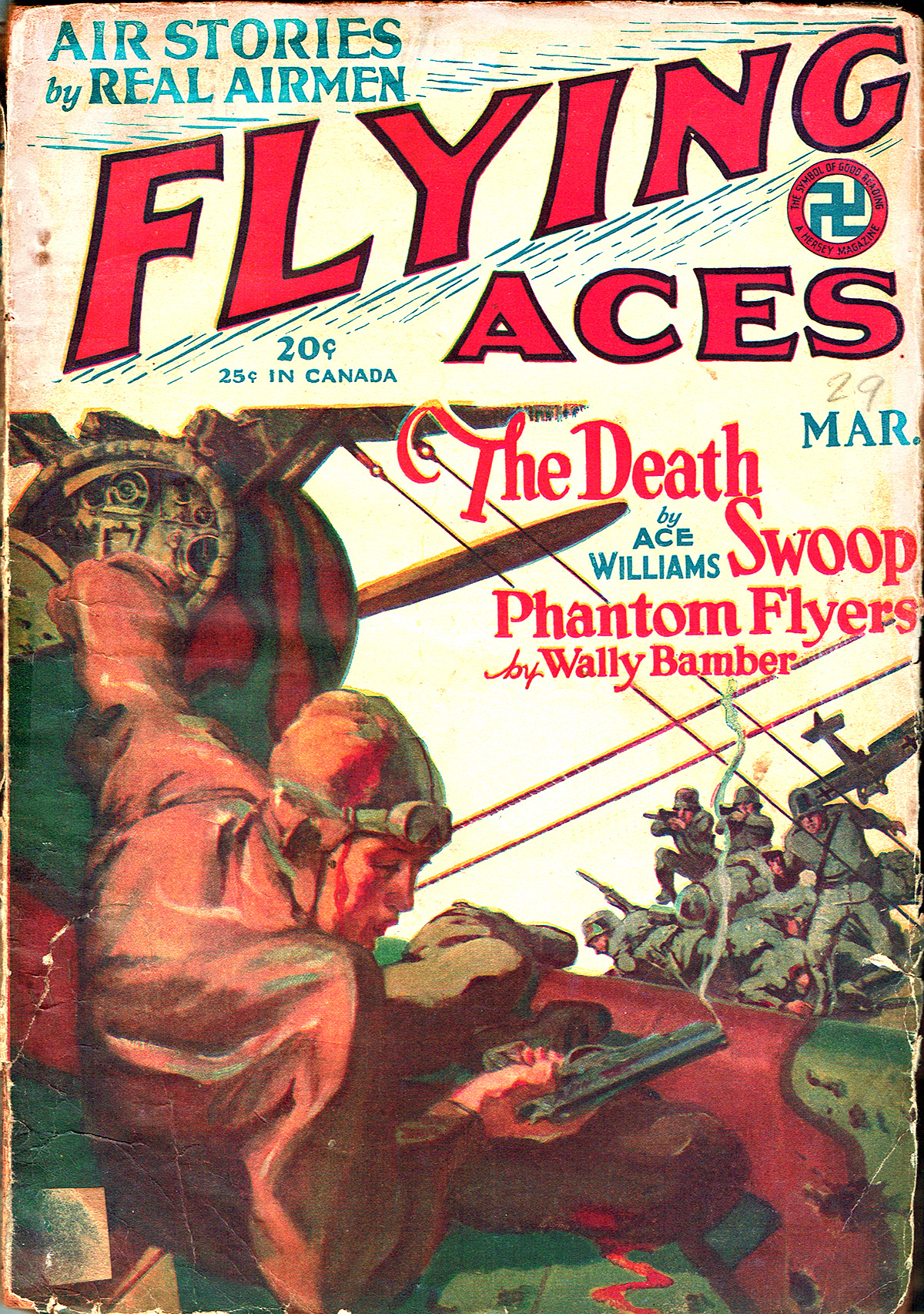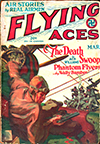“Martyrs of the Air: Frank Luke” by R.C. Wardell
THIS week we present an early Flying Aces cover from March 1929 by the incomparable R.C. Wardell. Wardell turned out numerous covers for the pulps in the late ’20’s and early ’30’s for magazines like Under Fire, Flyers, Flying Stories, Prison Stories, Sky Birds, Prize Air Pilot Stories, Far East Adventure Stories, Murder Stories, Murder Mysteries, Zoom! and of course Flying Aces, signing most of this work as “R.C. Wardel.” Here he depicts American Ace Frank Luke, shot down behind enemy lines waiting for the enemy troops to advance and take him prisoner—if they can!
Martyrs of the Air: Frank Luke
A German in name, but a fiery, patriotic American at heart, Frank Luke, the greatest ace that ever emblazoned his name in aviation annals, died as he had lived—a flaming, fighting, fast-winged warbird.
How much the name means to those few who knew how he fought, and died. And contrarily, how little it means to the vast majority of the great American people who knew so little about him.
Lieutenant Frank Luke’s career was short, hectic, and dynamic. He blazed across the wartorn skies of France like a flaming meteor and with equal brilliance. Very few people ever see the same blazing meteor in its dazzling course across the night skies; very few people ever heard of Lieutenant Frank Luke during his short but sensational career on the western front.
But to those who did come in contact with him, his valorous deeds and manner of dying will ever remain in their memories as long as they live. Frank Luke was the most courageous, the most audacious war bird that ever handled a control stick and pressed the Bowden triggers mounted on it.
Only Eddie Rickenbacker topped him in the final list of American Aces after the war was ended. Rickenbacker was officially credited with 26 victories. Frank Luke had 21. But the comparison is hardly fair to Frank Luke, for Eddie Rickenbacker was on the front for almost six months.
Luke’s front line career lasted only a little over two weeks, and even in that short space of time he was at one time the American Ace of Aces and there is no telling what score he would have run up if he hadn’t died. And how he died!
Bom of a German father who had emigrated to this country in the early days, and carrying a German name, Luke was looked upon with suspicion by his squadron mates who fraternized very little with him. Little did they suspect the intense hatred for the Germans that Luke harbored in his breast. He hated the enemy with an intensity of feeling that was only equalled by his supreme courage, and he swore when living that no German would ever take him alive. No German did.
There was another pilot in his squadron who had a German name and was of German parentage, a Lieutenant Wehner. The two, because they were more or less ostracized by the other members of the squadron, teamed up together. And what a team it was. The Germans soon learned to recognize the pair as twin furies of the skies, and would dash for cover as soon as the pair came in sight.
They were such dashing, daring fighters that the Germans gave them a clear sky when they came over, not even bothering to tarry and fight with them. Then it was that Luke originated his plans for bringing down German sausage balloons.
And what a terror the pair were to the German sausage observers—balloon after balloon fell before their streaking tracer fire. Finally, Wehner was killed while holding off an upper flight of German Fokkers who were trying to get at Luke below when he was diving on a German sausage with his twin Vickers guns blazing molten lead. Luke got the sausage, but the Fokkers got Wehner, and from that late afternoon on, Luke was never the same. He loved Wehner like a brother, and the Huns had got him.
“They’ll pay!†Luke stormed, and clenched his fists. “More than one Hun will pay for Wehner’s death.â€
And more than one Hun did!
HE HAD been a terror before. After Wehner’s death he became a raving, tearing madman of the skies. Flying alone thereafter, he was the Lone Wolf of the sky trails. He had but one consuming passion; that was to get the Huns and then more Huns. Flying wherever he willed he tore up and down the front lines in search of Hun meat.
He paid no attention to orders and had absolutely no regard for discipline. One night would see his Spad plane bivouaced at some strange French airdrome far from his own squadron. The next night he would be way across France over in Lorraine somewhere. During his flights between he left a path of desolation. The German feldwebels dubbed him the Scourge of the Skies and scurried for cover whenever they saw Luke’s plane skirting down the trench lines.
His own commanding officer never knew where he was or what he was doing. An old army sergeant, one John Monroe, who had charge of an advanced emergency landing field right behind the front lines perhaps knew more of Luke’s movements during his short career on the front than any other man. Luke spent many a night sleeping with Monroe in his pup tent.
The sergeant would service his plane for him each night he landed and make it ready to take off before dawn the next day. Then while the two laid in the tent trying to go to sleep, Luke would tell the sergeant of the events of the day as he saw them from the sky.
Luke’s last day on earth was a spectacular one. He brought down two sausage balloons and one Hun plane, and was himself shot down about five miles behind the German lines near the little town of Murveaux. Luke was not shot to death in the air, but bullets from a Hun Spandau had shattered his propellor and damaged his engine such that he had to make a forced landing behind the German lines.
In addition he had two slight flesh wounds which were not in themselves serious enough to cause death, but they did make him somewhat weak from loss of blood. While the crippled plane was Winging down to a landing with the Hun attackers hovering overhead, Luke spied a cutover wheat-field and by agile manoeuvering, managed to set his plane down safely on it.
To any ordinary pilot, that would have meant the end of the war. But, not so with Luke. A small company of German infantry were stationed at Murveaux not far from the wheatfield, and when they saw Luke’s plane land, they sauntered out to take him prisoner.
When Luke’s plane staggered to a dead stop Luke jumped out of the cockpit on the side nearest the approaching soldiers. His left hand dangled loosely from his-shoulder and blood was on his tunic sleeve. His right hand he kept inside the cockpit, apparently holding himself up, for his knees buckled and he was half slumped to the ground, and so the approaching captors thought.
Luke looked at them and let them come. On they came in sort of a half run with their bayonets fixed. Luke watched them out of the corner of his eyes, and clenched his right hand tighter. His body swayed a little and he reeled slightly, nevertheless he held his feet, and when th approaching Germans got within about 50 feet of him, he snapped his right hand out of the cockpit. In it was a Colt Automatic. Luke leveled it and fired pointblank into the faces of the captors.
Bang! Bang! Bang! Bang! Bang!
Five successive shots rang out. Five of the approaching Germans fell dead, shot through the heart each and every one of them.
More shots rang out, from the German’s rifles this time. Luke slumped over by the side of his machine, dead, his body riddled like a sieve by the German fire.
But think of the cold, raw courage that was Luke’s. In the height of battle man might do that, many of them. But Luke had time to think while his would-be captors approached.
“Surrender, and live through the war? Or die fighting with the blood of his comrade Wehner further avenged?â€
Frank Luke died, and how gallantly!

“Martyrs of the Air: Frank Lukeâ€
Flying Aces, March 1929 by R.C. Wardell





